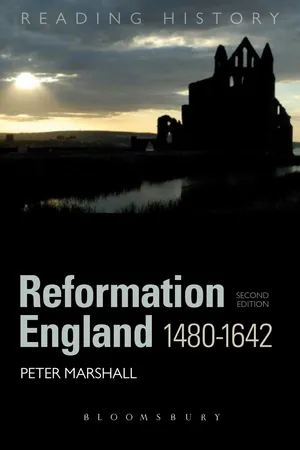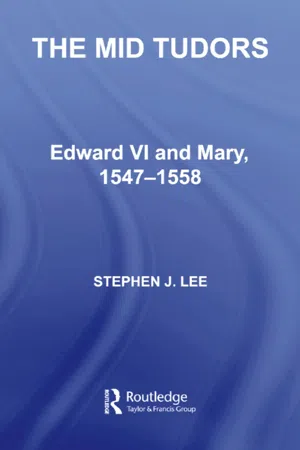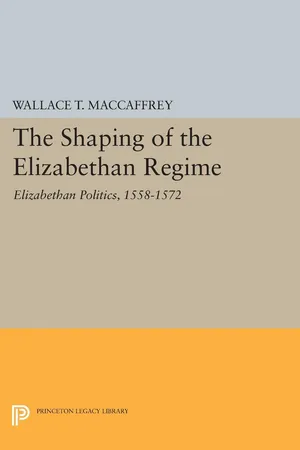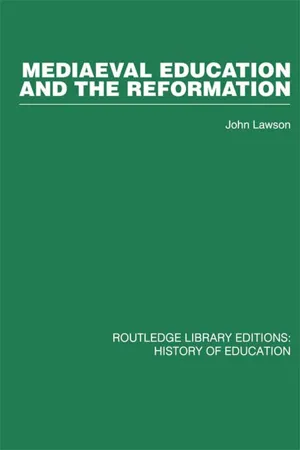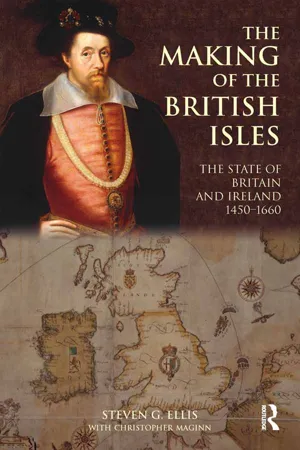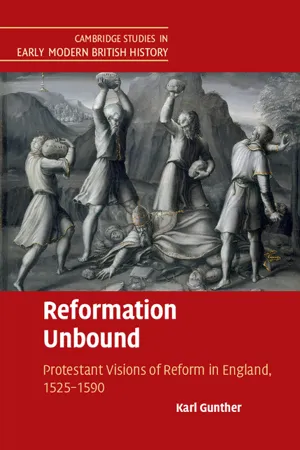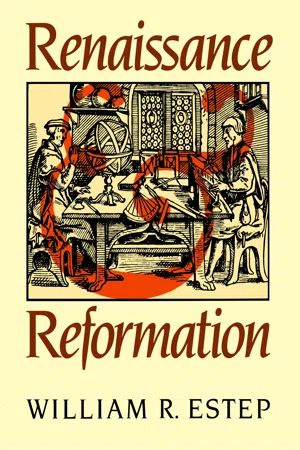History
Edwardian Reformation
The Edwardian Reformation refers to the religious changes implemented during the reign of King Edward VI of England in the mid-16th century. It involved a shift towards Protestantism, including the dissolution of monasteries, changes to religious practices, and the introduction of the Book of Common Prayer. The Edwardian Reformation had a significant impact on the religious landscape of England.
Written by Perlego with AI-assistance
Related key terms
1 of 5
10 Key excerpts on "Edwardian Reformation"
- eBook - PDF
- Peter Marshall(Author)
- 2012(Publication Date)
- Bloomsbury Academic(Publisher)
63 3 Edwardian revolution 1547–53 Overview Exiled on the continent in Queen Mary’s reign, the evangelical Richard Morison made an imposing claim about reformation in his homeland under Edward VI: ‘the greater change was never wrought in so short space in any country since the world was’. 1 The years 1547–53 witnessed an unprecedentedly intense campaign to transform the character of Christian worship and belief, one which fully justi-fies the label of revolution. 2 It was a revolution too in the more original sense of a complete rotation, an attempt to turn back to the purity of the Church of the apostles, and to strip away the accretion of centuries: the cult of the saints, pur-gatory, a warped theology of sacraments and the mass. The modern analogy is less with the overthrow of anciens regimes in 1789 and 1917 than with the ‘cultural revolution’ of 1960s China, in which central government worked in alliance with cadres of true believers to undermine unreliable elements in positions of author-ity, and radically reconstruct the outlook of the people as a whole. Despite all this, Edward’s reign has, until comparatively recently, been the neglected orphan of English Reformation studies. In part, this was because a nationalist historiography found little to celebrate in what seemed a brief and confusing interlude between the Tudor glories of Henry and Elizabeth. In part, also, it was because the crusading Protestant zeal of Edwardian reform-ers has been something of an embarrassment to an Anglican tradition which came eventually to define itself as a moderate arbiter between the best aspects of Protestantism and Catholicism. Thus, in the late 1940s, the Anglo-Catholic 1 Diarmaid MacCulloch, Tudor Church Militant: Edward VI and the Protestant Reformation (London, 1999), p. 102. 2 T. M. Parker, The English Reformation to 1558 (Oxford, 1950), Chapter 8, ‘The Protestant Revolution’; Philip Hughes, The Reformation in England (3 vols, London, 1950–4), ii. - eBook - ePub
The Mid Tudors
Edward VI and Mary, 1547–1558
- Stephen J. Lee(Author)
- 2006(Publication Date)
- Routledge(Publisher)
Probably the Edwardian Reformation was a synthesis of all forms of Protestantism grafted on to the partially Catholic variant of the previous reign. It therefore makes more sense to criticise the religious establishment not so much for introducing a religious ‘anarchy’, but rather for failing to impress the new doctrinal synthesis on the population. This, in essence, meant a failure of communication and education. J. Guy argued: ‘However, rural areas and small towns had little contact with reformed preaching: outside London, the south-east, and the universities there were few Protestant “conversions”.’ 13 Hence the underlying attitude of most of the population was still ambivalence, even confusion. This was a result less of the terror imposed upon them by Henry VIII, since much of that had now gone. Instead, it was based even more on a wait-and-see approach, except in so far as specific groups were stung into action at particular times. The Edwardian Reformation did surprisingly little to accelerate the popular trends taking place during the previous reign. Perhaps this was because the changes being introduced by the administration were being cautiously digested by the rest of the population. Some of the latter became full converts; some retained what they could of their traditional faith, while adapting where they had to; others simply did what they were told. Another approach to the debate has come from the direction of the survival of Catholicism. Not only was the majority of the population not convinced by or committed to advancing Protestantism; a substantial proportion of it actually remained loyal to Catholic traditions. According to C. Haigh, Lancashire was a case in point: ‘The fairly intensive efforts at conversion made in the reign of Edward had reaped only a meagre harvest, and Protestantism had gained very little support by 1559.’ 14 There is also a case made for the survival of positive influences from the traditional church, emphasised by E - No longer available |Learn more
- (Author)
- 2014(Publication Date)
- White Word Publications(Publisher)
Church reform was therefore as much a political as a religious policy under Edward VI. By the end of his reign, the church had been financially ruined, with much of the property of the bishops transferred into lay hands. The religious convictions of both Somerset and Northumberland have proved elusive for historians, who are divided on the sincerity of their Protestantism. There is less doubt, however, about the religious devotion—some have called it bigotry—of King Edward, who was said to have read twelve chapters of scripture daily and enjoyed sermons, and was commemorated by John Foxe as a godly imp. Edward was depicted during his life and afterwards as a new Josiah, the biblical king who destroyed the idols of Baal. He could be priggish in his anti-Catholicism and once asked Catherine Parr to persuade Princess Mary to attend no longer to foreign dances and merriments which do not become a most Christian princess. Edward's biographer Jennifer Loach cautions, however, against accepting too readily the pious image of Edward handed down by the reformers, as in John Foxe's influential Acts and Monuments , where a woodcut depicts the young king listening to a sermon by Hugh Latimer. In the early part of his life, Edward conformed to the prevailing Catholic practices, including attendance at mass: but he became convinced, under the influence of Cranmer and the reformers among his tutors and courtiers, that true religion should be imposed in England. ________________________ WORLD TECHNOLOGIES ________________________ Thomas Cranmer, Archbishop of Canterbury, exerted a powerful influence on Edward's Protestantism. The English Reformation advanced under pressure from two directions: from the traditionalists on the one hand and the zealots on the other, who led incidents of iconoclasm (image-smashing) and complained that reform did not go far enough. - eBook - PDF
The Shaping of the Elizabethan Regime
Elizabethan Politics, 1558-1572
- Wallace T. MacCaffrey(Author)
- 2015(Publication Date)
- Princeton University Press(Publisher)
In this restricted political universe the course of the English Reformation produced explosive effects. First of all there was the irony of chance circumstance which, at the very crisis of religious revolution, placed on the throne first a child and then a woman of great personal courage but limited political acumen. Such circumstances would in any event have seriously disordered a political world so pivoted on the monarch, but these seasonal storms were warnings of long-term changes in the whole climate of English politics. IO TROLOGUE TO A REIGN In the first and most obvious instance the Reformation altered English politics by fostering faction. Over the pre- vious half-century the power of the monarchy had pretty effectively extinguished the dynastic or semi-feudal fac- tionalisms of the past; now the realm was threatened by internal disunity of a more serious and far more danger- ous kind. Even before the death of Henry the nuclei of two opposing religious parties were forming in the court, and in the years after 1547 England was governed suc- cessively by two rancorously partisan regimes, Protestant under Edward, and Catholic under Mary. Each of these sovereigns thus became the leader of a religious faction, and the Crown's neutrality towards the major religious issues of the Reformation, which Henry with some suc- cess had struggled to maintain, was irretrievably lost. Elizabeth was left with no choice but to assume a partisan position at her accession. The question now was whether or not the Catholic party, left leaderless by Mary's death, could recover itself for a return bout to recapture power. To contemporaries this seemed likely enough, and fear of this possibility haunted Elizabethan ministers in the first decade of the new reign; the Catholic political failure is one of the themes dealt with in this book. - eBook - ePub
- John Lawson(Author)
- 2013(Publication Date)
- Routledge(Publisher)
The final stage was the reformation of doctrine; deeply influenced by Calvinism, this started under Edward VI and, after the brief Catholic reaction of Mary’s reign, was accomplished in the early years of Elizabeth’s. The Church of England that emerged preserved intact its ancient episcopal organization and legal structure, but had a new liturgy embracing Catholic and Protestant elements, set out in English in the Prayer Book; and a broad compromise theology summarized in the Thirty-nine articles. In 1559 the Queen was made its ‘Supreme Governor’ by the Supremacy Act; and by the Uniformity Act of the same year all her subjects were obliged under penalty to accept its form of worship and none other. During the greater part of Elizabeth’s reign the overriding concern of the central government was to strengthen this new religious establishment, and protect it from dissentient minorities—Catholics on the one hand, and, to a less extent, radical Calvinist nonconformists on the other. 57 The Reformation and education in England The English Reformation was thus a thoroughly revolutionary movement, but one smoothly and peacefully carried out. It affected not only the religious beliefs and practice of English people, but also the constitution, the social life and economic structure of the country, reacting in ways which cannot be defined precisely with other developments that were simultaneously changing society. A fast growing population and consequent inflation were the concomitants of Reformation, and in their effects on education were perhaps in the long run of even greater significance. The decline in the territorial power of the Church was also accompanied by the rise of a new class of landed gentry, many of them with a stake in former monastic and chantry estates, who came to control policy and government as Members of Parliament and justices of the peace - eBook - ePub
The Making of the British Isles
The State of Britain and Ireland, 1450-1660
- Steven G. Ellis, Christopher Maginn(Authors)
- 2014(Publication Date)
- Routledge(Publisher)
22 Elsewhere, in the south-east, social conflict was to be a much more evident precipitant of rebellion in 1549 (discussed below, pp. 192–6) but there, intriguingly social unrest combined with Protestantism as a means of legitimating popular socio-economic grievances.The death of ‘the virtuous imp’, Edward VI, stopped the Reformation in its tracks. As quickly became apparent, the Edwardian reforms were chiefly the product of state power rather than of popular conviction. For this reason, the Marian regime had little difficulty in suppressing reform once the statutory instruments underpinning the settlement had been withdrawn. In autumn 1553, pending the repeal of the Acts of Uniformity, the Edwardian settlement remained officially in force, but Mary sanctioned Catholic worship alongside it, and indeed the mass had already been spontaneously restored in many parts. From December, the religious settlement reverted to that at the end of Henry VIII's reign, and finally in January 1555 the Second Statute of Repeal restored full communion with Rome.23 In Ireland, Lord Deputy St Leger was simply instructed in October 1553 that religion should be that ‘of old time used’; although a parliament eventually met in 1557 to repeal the Henrician legislation.24The Elizabethan settlement
Mary's reign was to prove even shorter than that of her half-brother, however, and in 1559 the authorities moved once again to restore a national church. Queen Elizabeth apparently began by using the 1549 liturgy in the Chapel Royal, but she soon realised that this was no longer acceptable even to moderate Protestants. Probably, when parliament met to discuss religion in January 1559, she aimed at restoring the 1552 prayer book, although the evidence is unclear. At any rate, the government's reform programme was blocked, apparently by conservative opposition in the Lords. Accordingly, Elizabeth decided on an additional parliamentary session after Easter. She introduced two new bills for Supremacy and Uniformity so as to divide the opposition, and some concessions were also made to conservative opinion: as a result, Supremacy passed comfortably, Uniformity very narrowly. The Act of Supremacy now declared Elizabeth Supreme Governor (rather than Supreme Head) of the church (but with the same powers), empowering her to visit and correct the church through commissioners; it repealed the heresy laws and provided that nothing was to be adjudged heresy except on the authority of the scriptures or the first four general councils of the church; it revived ten statutes of Henry VIII, including the Act of Appeals; and it imposed an Oath of Supremacy on office holders in church and state. - eBook - ePub
Ireland in the Age of the Tudors, 1447-1603
English Expansion and the End of Gaelic Rule
- Steven G. Ellis(Author)
- 2014(Publication Date)
- Routledge(Publisher)
cuius regio eius religio , whereby in most parts of Europe the prince eventually managed to impose his own brand of Christianity on his subjects. And Elizabeth’s long reign allowed her settlement sufficient time to put down roots, so that after 45 years of protestant services the vast majority of the queen’s subjects had grown to accept the Elizabethan church. Ireland and the Netherlands, however, constitute the two most obvious departures from the normal pattern: and arguably in both countries, the religious divisions created by the reformers’ comparative failure in Ireland and their overall success in the Low Countries were to bulk large in the events leading to the political partition of the two territories, almost immediately in the case of the Netherlands, much later in Ireland. Nevertheless it would be a mistake to conclude either that the divided state of late medieval Ireland posed insuperable obstacles to reform, or that it necessarily explains why post-Tridentine catholicism came to establish itself most strongly among the Old English merchants and gentry. In fact, as we have seen in the last chapter, the ecclesiastical state of early Tudor Ireland was not uniformly less favourable to reform than England, but contained certain mitigating influences which at least facilitated its initial reception.The Introduction of the Edwardian Reformation
The introduction of a protestant religious settlement under Edward VI shed a very different light on what had hitherto appeared as the erection of individual provinces of the medieval church into a distinct national church, governed by the territorial ruler as supreme head, but still part of the universal catholic church. Conservative clergy who had accepted the royal supremacy as a means to the religious reform that was so patently necessary now discovered that it might equally be used to promote Zwinglian doctrines; and in Ireland where conservative supporters of the supremacy far outnumbered any protestants, this shift in policy was particularly serious. The administration’s difficulties were also compounded by a concurrent change in governmental strategy (see below, Ch. 11 ) which alienated much local support. Yet the new regime’s political priorities and also political unrest in Ireland obliged it to temporize on religion, with the result that change was gradual and its impact in Ireland the less disruptive.1 - eBook - PDF
Reformation Unbound
Protestant Visions of Reform in England, 1525–1590
- Karl Gunther(Author)
- 2014(Publication Date)
- Cambridge University Press(Publisher)
4 When historians have addressed divisions within the early evangelical move- ment, they have focused primarily on Eucharistic theology and the question of Christ’s presence in the Eucharist. It is of course a commonplace that evangelicals were among the staunchest supporters of Henry VIII’s break with Rome and his assertion of royal supremacy over the Church of England – hardly an insignificant point of ecclesiastical governance – but beyond support for the abolition of papal authority, it has been assumed that the “nature of the external government of the church had not been a topic of much significance for early English protestants.” 5 Only after achieving doctrinal and liturgical reformation in the reign of Edward VI, it has been argued, did Protestants then go further and hesitantly begin to consider reforming the church’s governance and discipline. 6 This 3 Paul D. L. Avis, The Church in the Theology of the Reformers (Atlanta, 1981), 35. When discussing English Protestantism, Avis treats concern with discipline as an Edwardian and Marian development, fully flourishing then among the Elizabethan presbyterians and separatists (pp. 61–66). 4 See Dickens, The English Reformation; Marshall, Reformation England; Ryrie, The Age of Reformation; Ryrie, “The Strange Death of Lutheran England”; Benedict, Christ’s Churches Purely Reformed, ch. 8; Duffy, Stripping of the Altars, pt. 2; Felicity Heal, Reformation in Britain and Ireland (Oxford, 2003), esp. 333, 347. Doctrine is the focus of William A. Clebsch, England’s Earliest Protestants, 1520–1535 (New Haven, CT, and London, 1964). Carl R. Trueman, Luther’s Legacy: Salvation and English Reformers, 1525–1556 (Oxford, 1994) revises and supersedes Clebsch’s study in a variety of important ways, but focuses entirely on soteriology. 5 Peter Lake, Anglicans and Puritans? Presbyterianism and English Conformist Thought from Whitgift to Hooker (London, 1988), 1. - eBook - PDF
- Richard Rex(Author)
- 2006(Publication Date)
- Bloomsbury Academic(Publisher)
Chapter 6: The Politics of Religion In the later Middle Ages, the Christian basis of European society was so widely assumed and enforced that, notwithstanding the rise in academic circles of naturalist and Aristotelian thinking about politics since the thirteenth century, in practice it was difficult for European Christians to imagine that stable societies could exist on any other foundation than the Catholic faith. One of the main long-term outcomes of the changes of the sixteenth and seventeenth centuries was the spreading realisation that societies could not only exist but even flourish on radically different theological or ideological foundations. The possibility of such a shift in thinking was evident even before Henry VIII’s Reformation, in the alternative worlds presented respectively by Thomas More and Niccolò Machiavelli in the sixteenth century’s two most original works of political thought, Utopia and the Prince . But the fact that these texts were seen by most readers as exercises in, respectively, light-hearted satire and satanic depravity shows just how far away that possibility still was. Those long processes of change which we call the Reformation and the Counter-Reformation, with their manifold political consequences for the internal arrangements and the external relations of European kingdoms and republics, were central to the gradual shifts in thinking which took place over those centuries, culminating in the radically different understand-ing of the place of religion in society which dominated the thought of the Enlightenment and of the American and French Revolutions. When Henry VIII came to the throne in 1509, the place of the Catholic Church in the kingdom of England was central and apparently secure, defined and guaranteed in Magna Carta, enforced through the church’s own autonomous courts, and backed by the ultimate sanction of the 135 HENRY VIII AND THE ENGLISH REFORMATION 136 statute for the burning of heretics. - eBook - ePub
- William R. Estep(Author)
- 1986(Publication Date)
- Eerdmans(Publisher)
As it turned out, the council of regents that took over the reins of government was weighted in favor of the Reformation. Shortly after Edward’s coronation, the new council moved swiftly to compel all the bishops of the realm to take out new commissions in the name of the nine-year-old king. The Lord Chancellor Wriothesley, who under Henry had opposed further reforms, was forced to resign. Edward Seymour, earl of Hertford, a convinced Calvinist, was declared protector. It was soon clear that the Church of England would either voluntarily move toward or be pushed toward a more Protestant pattern of faith and order.This Protestant emphasis was evident in the new series of injunctions published in July 1547, which were designed to encourage the reading of the Scriptures in English and further stifle Roman Catholic practices. A royal visitation also began in 1547 to determine the biblical knowledge of the clergy and the measure of their commitment to the Reformation. During Bishop Hooper’s visitation of his diocese of Gloucester in 1551, 311 clergymen were examined. Of these, 168 were unable to repeat the Ten Commandments. Ten couldn’t repeat the Lord’s Prayer, thirty-four couldn’t name its author, and thirty-nine couldn’t tell where it was found. If this examination rendered a fair sample of the biblical literacy of the English clergy two years before the end of Edward’s brief reign, the Church of England was far from being either informed or reformed.However, Parliament did make some sweeping changes during Edward’s reign. The first Parliament revoked the Act of the Six Articles and all acts concerning heresy that had been passed since the days of Richard II. Convocation also inaugurated significant changes: it ruled that participants in the Lord’s Supper were to receive both bread and wine, and it declared null and void all ecclesiastical laws against married clergy. Parliament promptly passed acts approving the changes.
Index pages curate the most relevant extracts from our library of academic textbooks. They’ve been created using an in-house natural language model (NLM), each adding context and meaning to key research topics.
